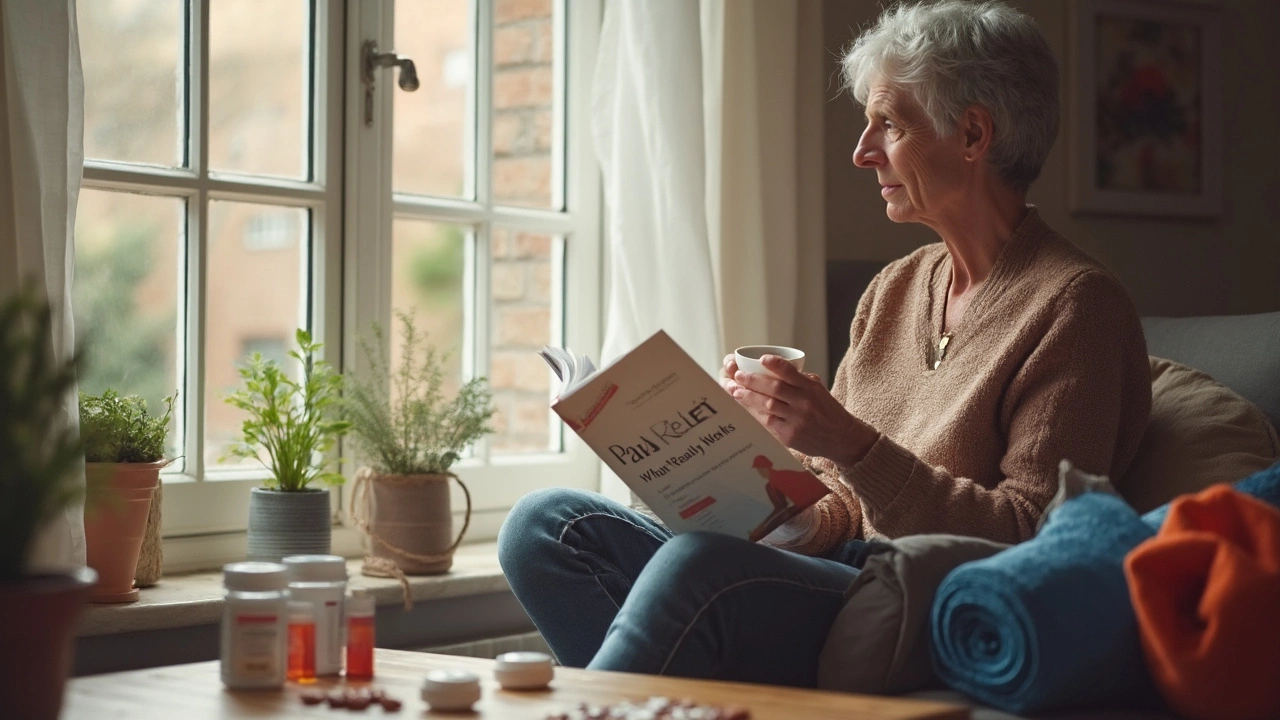
You wake up and pain is the first thing you notice. Maybe it’s a dull ache that nags every day, or maybe it’s that sharp, stabbing feeling that shows up just when you’re trying to get things done. No wonder the search for the most powerful pain relief feels like a never-ending quest.
People usually think the strongest pain relief must be some heavy-duty prescription, but it's not that simple. Powerful pain relief isn't always about what knocks you right out—it’s about what helps you function, not just for one day but over months or years without wrecking your body in the process.
If you’re tired of all the confusing options—painkillers, patches, creams, electric gadgets, herbal so-called miracles—you’re not alone. Here’s the thing: not every treatment works the same for everyone. What actually matters is finding something that gives real, lasting relief with the least amount of trouble on the side.
- Painkillers: From Over-the-Counter to Prescription
- Non-Drug Solutions: Beyond Pills
- Surprising Options That Work
- Balancing Effectiveness and Risks
Painkillers: From Over-the-Counter to Prescription
When most people think about knocking out pain, they usually reach for an over-the-counter bottle first. You’ve probably used ibuprofen (Advil), acetaminophen (Tylenol), or naproxen (Aleve) at some point. These meds work well for mild aches and even some moderate pain, especially headaches or joint soreness. But they can only do so much for hardcore, long-lasting pain.
Now, here’s something useful: take a look at how these common painkillers stack up when it comes to chronic pain relief and risks. A lot of folks just grab whatever’s in the medicine cabinet, not knowing when it stops being safe or effective. Here’s a quick breakdown:
| Painkiller Type | Common Brands | Best For | Risks |
|---|---|---|---|
| Acetaminophen | Tylenol | Headaches, minor pain | Liver damage (if overused) |
| NSAIDs | Advil, Aleve | Muscle/joint pain, inflammation | Stomach ulcers, kidney issues |
| Prescription Opioids | OxyContin, Vicodin | Severe chronic pain | Addiction, overdose, constipation |
If you’re dealing with pain day after day, you might wonder if it’s time to move beyond pharmacy shelves. That’s where prescription painkillers come in—the big guns, but they’re not magic. Opioids like oxycodone or hydrocodone do pack a punch for short-term use. But doctors are super strict with these now because of addiction risks. The CDC reported in 2023 that nearly 40% of opioid overdose deaths were from prescription meds, not street drugs.
Some prescription painkillers aren’t opioids. For nerve pain, drugs like gabapentin or pregabalin can help. There’s also muscle relaxers if your pain is tied to spasms. But none of these are a perfect solution. Every single one has a possible downside, like drowsiness or mood changes.
- Stick with the lowest dose that gets the job done. Don’t double up “just in case.”
- If your pain lasts longer than a few weeks, or over-the-counter meds aren’t cutting it, talk to your doctor. Don’t self-diagnose or borrow someone else’s prescription.
- Keep track of how much you’re using—set a reminder if you need to.
The bottom line: The most powerful pain relief isn’t just about grabbing the pill with the sharpest sting. It’s about finding a balance, watching for side effects, and never losing sight of what keeps you functioning day to day. For folks with chronic pain, that usually means mixing meds with other treatments (more on that coming up).
Non-Drug Solutions: Beyond Pills
Pills aren't the only answer—sometimes, the best pain relief comes from things you can do yourself, right at home. Not everyone wants to pop pills forever or deal with nasty side effects, right? Here’s a look at what actually helps, based on real studies and people’s experiences.
Let’s kick it off with physical therapy. It’s not flashy, but consistent work with a physical therapist can bring lasting changes. A 2023 study from the American Physical Therapy Association found that about 68% of chronic pain patients reported better daily function after 12 weeks of customized exercises. They’re not miracle moves, just gentle stretching, targeted strengthening, and posture tweaks that actually make joints and muscles work better.
Don’t overlook heat and cold packs. They’re basic, but science shows they help. Applying a warm pack to stiff areas can improve blood flow and ease tension (think 15-20 minutes at a time). Cold packs, on the other hand, can cut down swelling after a flare-up or injury.
Some people swear by TENS units (Transcutaneous Electrical Nerve Stimulation). That’s just a tool with sticky pads and mild zaps that can disrupt pain signals. According to a 2022 Mayo Clinic report, around half of people with nerve pain felt at least temporary relief from using a TENS unit daily.
Now, if sleep is a mess, pain gets worse. Fixing sleep routines pays off—cutting down screen time before bed, keeping your bedroom cool, and sticking to a set sleep schedule all makes a difference.
- Try gentle yoga or tai chi. Both are proven to lower pain and stress, according to several hospital studies from 2021 and 2022.
- Mindfulness meditation isn’t just a trendy buzzword—it actually re-trains the way your brain responds to pain signals. People who practice even 10 minutes a day show lower pain scores on average, according to Harvard research.
- Regular movement matters. Even walking every day helps keep nerves and muscles from locking up.
If you’re a numbers person, check out this quick stats table on how common non-pill options stack up:
| Method | % People Reporting Relief |
|---|---|
| Physical Therapy | 68% |
| TENS Unit | 50% |
| Yoga or Tai Chi | 57% |
| Mindfulness Meditation | 45% |
| Heat/Cold Packs | 60% |
It’s all about stacking up simple daily habits for better control over chronic pain. You don’t have to do everything, but mixing a couple of these can often make a bigger dent than you’d expect—especially if meds aren’t doing the job or the side effects are just too much.

Surprising Options That Work
So many people miss out on pain relief that actually helps, just because it doesn't come in a pill bottle. Sometimes, the weirdest or simplest solutions can make you feel a lot better—especially when you’re dealing with chronic pain every single day. What really works might sound surprising, but the numbers and experts back it up.
One example? Cognitive Behavioral Therapy (CBT). It's not just "talk therapy." It helps you change the way your brain responds to pain. In fact, a 2021 study in JAMA Internal Medicine showed that CBT reduced pain intensity by about 25% in people with chronic back pain, compared to doing nothing different. That's not just in their heads. Real brain scans prove the brain lights up differently after a few weeks of CBT.
Then there’s movement—yeah, the exact thing you probably want to avoid when you hurt. But gentle activity like walking or water aerobics eases stiffness and boosts your body’s natural painkillers. Physical therapy, even if it sounds basic, has more long-term effect than resting in bed, according to several controlled trials.
"People living with chronic pain are often surprised when something like regular movement turns out to be more powerful than medication for improving daily life," says Dr. Lynn Webster, past president of the American Academy of Pain Medicine.
Other options? Check these out:
- Heat and cold therapy: Hot packs ease tight muscles. Ice packs help numb sore spots. It seems old-school but a review in BMJ found it works for about 6 out of 10 pain sufferers.
- Acupuncture: Not everyone’s cup of tea, but a big analysis in 2022 saw about a 20% drop in pain scores for people who stuck with it over three months vs. usual care.
- Topical creams: Stuff like lidocaine patches or capsaicin creams actually block pain signals when applied to the skin, especially useful for nerve pain or joint pain close to the surface.
- TENS units: These little gadgets send mild electrical pulses through your skin. When scientists compared TENS to "fake" (non-working) units, about 30% more people said TENS made a real difference in their daily pain scores.
Here's a quick look at what works and how many people find real relief:
| Option | Improvement Rate | Main Benefit |
|---|---|---|
| CBT (therapy) | 25% pain reduction | Long-lasting brain & mood shift |
| Gentle Movement | 30-40% function boost | Greater flexibility & independence |
| Acupuncture | 20% pain drop | Drug-free relief |
| Heat/Cold Therapy | 60% report relief | Fast, home-based solution |
| TENS Units | 30% better pain control than "fake" devices | Portable, no meds needed |
If you feel like you’ve tried “everything” and still don’t have control over pain, don’t overlook these. Sometimes, it’s a mix of these things—therapy, movement, gadgets, and over-the-counter fixes—that ends up as the real game-changer.
Balancing Effectiveness and Risks
When it comes to strong pain relief, it’s never just about what’s most powerful. Everything you put in your body, even over-the-counter stuff like ibuprofen, comes with some risk. Prescription painkillers like opioids might wipe out severe pain for a while, but it’s no secret that long-term use can lead to addiction, drowsiness, or even make pain worse over time—a problem doctors call opioid-induced hyperalgesia. According to the CDC, “Opioids should not be considered first-line or routine therapy for chronic pain.”
But don’t get fooled by marketing hype for so-called "natural" remedies either. Some herbal products can mess up your liver or kidneys, especially if you’re already taking other meds. Even regular NSAIDs (like ibuprofen or naproxen) aren’t risk-free if you take them for months—they can hike up your risk of ulcers, stomach bleeding, or kidney problems.
The trick is to figure out what gives the best relief for your type of pain with the least problems. Here’s what works for many people:
- Start with the lowest effective dose for the shortest possible time.
- Mix things up: Physical therapy, stretches, or even things like meditation can boost pain relief when meds alone aren’t enough.
- Review your current medications regularly. New combinations or higher doses can sometimes sneak up and cause trouble.
Certain chronic problems, like nerve pain, respond better to non-traditional medicines like gabapentin or duloxetine than to classic painkillers. If side effects pop up, tell your doctor right away—don’t just tough it out.
“There’s no magic bullet for chronic pain. It’s almost always about careful trade-offs, not chasing the strongest pill,” says Dr. Beth Darnall, a pain specialist at Stanford University.
Remember, the goal isn’t to erase all discomfort. It’s to help you move, sleep, and function with as few risks as possible. That’s what real pain relief looks like in the long run.